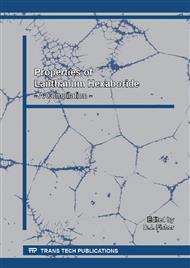[1]
A. S. Rao, B. Sreedhar, J. L. Rao and S.V.J. Lakshman, J. Non-Cryst. Solids, Vol.144(1992), p.169
Google Scholar
[2]
K. Srinivasulu, I. Omkaram, H. Obeidc, A.Suresh Kumar and J.L. Rao, Physica B, Vol.407(2012), p.4741
Google Scholar
[3]
R. H. Page, K. I. Schaffers, L. D. Deloach, G. D. Wilke, F., D. Patel, J. B. Tassano, S. A. Payne, W. F. Krupke, K. T. Chen and A. Burger, IEEE J. Quantum Elect, Vol. 33 (1997), p.609
DOI: 10.1109/3.563390
Google Scholar
[4]
S. Y. Wu, X. Y. Gao and H. N.Dong, J. Magn. Magn. Mater, Vol. 301(2006), P. 67
Google Scholar
[5]
W. H. Wei, S. Y. Wu and H. N. Dong, Z. Naturforsch, Vol. 60a(2005), p.541
Google Scholar
[6]
W. L. Feng, Phil. Mag. Lett, Vol. 87(2007), p.663
Google Scholar
[7]
R. P. S. Chakradhar, A. Murali and J. L. Rao, J. Alloys Compd, Vol. 265(1998),p.29
Google Scholar
[8]
R. M. Krishna, J. J. André, V. P. Seth, S. Khasa and S. K. Gupta, Opt. Mater,Vol. 12(1999), p.47
Google Scholar
[9]
H.N. Dong, Z. Naturforsch, Vol.60a(2005), p.615
Google Scholar
[10]
W. L. Feng, Y. M. Nie, N. Hu, W. Z. Zhang, Y. Wu and T. H. Chen, Spectrosc. Lett, Vol.41(2008), p.151
Google Scholar
[11]
H. M. Zhang and X. Wan, J. Non-Cryst. Solids, Vol. 361(2013), p.43
Google Scholar
[12]
W. C. Zheng, Y. Mei, Y.G. Yang, H.G. Liu, Philos. Mag, Vol.92(2012), p.760
Google Scholar
[13]
H. M. Zhang, S. Y. Wu, Z. H. Zhang, Condens. Matter Phys, Vol. 14(2011),p.23703
Google Scholar
[14]
W. Q. Yang, L. He, H. G. Liu, W. C. Zheng, Phys. Status Solidi B, Vol. 246(2009), p. (1915)
Google Scholar
[15]
Z. Y. Yang, C. Rudowicz, and J. Qin, Physica B, Vol. 318(2002), p.188
Google Scholar
[16]
M. G. Zhao, J. A. Xu, G. R. Bai, and H. S. Xie, Phys. Rev B, Vol. 27(1983), p.1516
Google Scholar
[17]
J. S. Griffith: The Theory of Transition-metal Ions(Cambridge University Press, London , 1964)
Google Scholar
[18]
H. N. Dong, S. Y. Wu and P. Li, Phys. stat. sol. (b) , Vol. 241(2004), p. (1935)
Google Scholar
[19]
D. J. Newman and B. Ng, Rep. Prog. Phys, Vol. 52(1989) ,p.699
Google Scholar
[20]
C. K. Jørgensen: Absorption Spectra and Chemical Bonding in Complexes(Pergamon Press, Oxford, 1962)
Google Scholar
[21]
S. Y. Wu, H. M. Zhang, P. Xu and S. X. Zhang, Spectrochim. Acta A, Vol. 75(2010), p.230
Google Scholar


